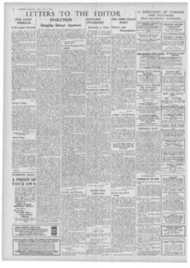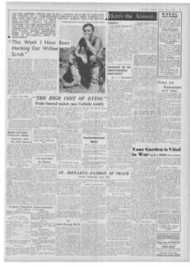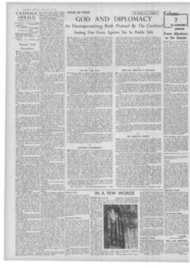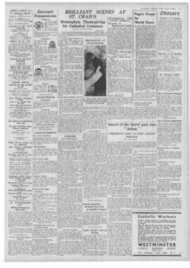Page 7, 27th June 1941
Page 7
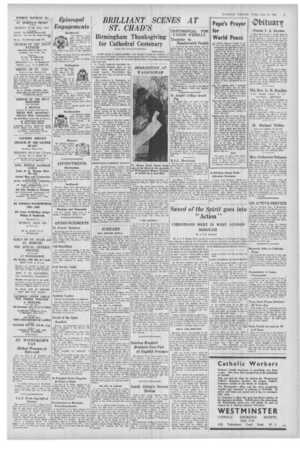
Report an error
Noticed an error on this page?If you've noticed an error in this article please click here to report it.
Tags
Share
Related articles
Birmingham Cy Ms To Hold Holy Hour
Birmingham Cathedral
Raid Damage To St, Chad's Cathedral
Centenary Booklet Of Birmingham Cathedral
Chapter Centenary
BRILLIANT SCENES AT ST. CHAD'S
Birmingham Thanksgiving for Cathedral Centenary
From Our Own Correspondent
Amidst scenes of solemn grandeur and liturgical pomp the centenary of the opening of St Chad's Cathedral, Birminrgham, the first Catholic cathedral to be erected in England after the so-called Reformation, was celebrated during this week-end.
St. Chad's, interiorly beautified for its hundredth birthday, bears on its crusted fabric the bomb-scars of present tragedy. Nevertheless, the papal flag flew high and proud on the Cathedral mast.
The Archbishop of Birmingham announced to.the members of the Metropolitan Chapter that His Holiness had honoured the occasion by making the Cathedral's Administrator (the Very Rev. Canon John Roskell) and the Rector of Oscott College (the Very Rev. Leonard Emery) Domestic Prelates.
On Saturday Archbishop Williams celebrated Pontifical High Mass; Archbishop Godfrey was the celebrant on Sunday ; and Bishop Griffin, Bishop-Auxiliary in the See of Birmingham, was the celebrant on Monday.
The centenary sermon was preached on Sunday morning by the Archbishop of Birmingham, and at night the Apostolic Delegate spoke of the war anil Catholic thought.
Such is an epitome of three days' celebradons. In the shadows of European upheavals, bishops and clergy decided to confine the commemoration to devotional meetings, but the Chapter had a social gathering, and on Monday the clergy were given an opportunity at a luncheon of Meet ing the Apostolic Delegate. Nor did the City itself allow a page of history to be turned unheeded. Unfortunately, as he expressed it in a message, the Lord Mayor had to be on official business in Wales. But his welcome was given by Alderman T. B. Pritchett, his deputy, during a civic reception to the Apostolic Delegate in the Council House. Here, Archbishop Godfrey signed the Distinguished Visitors' Book and, with graceful phrase, thanked the civic hosts for the particular happiness of their welcome.
BIRMINGHAM CATHOLICS' LOYALTY The Apostolic-Delegate assured them that in the city they would find no more loyal citizens than the Catholics. That loyalty was, he added, a part of the obedience of the Church. In a reference to the war. Archbishop Godfrey also assured his hearers Mae in the Pope there was no greater or more outstanding example of one essaying continually to alleviate the sorrows of the world, For anxious hearts he was for ever striving to do his best.
For this great occasion the Cathedral had been beautified over a long period by Mr. O'Malley and his band of workers. All the delicate Pugin work, hidden under the film of decades of years, once more saw the light to lend colour to the general scene. In the sanctuary, aromatic with the scents of summer blooms, there was an ethereal mist of golden hue as into its candle-lit centre the Archbishop approached with his long retinue. Surrounding him were all the members of the Chapter, clad in their purple mozettas. On the fringe outside the sanctuary stood in evening dress the Papal Knights, Alderman T. 0. Williams (a former Lord Mayor of Birmingham) and Mr. J. T. Hardman, filling the ancient role of Magistratus.
13efore the service began the Rev. Dr. Regmald O'Reilly, rector of the Mother Church of St. Peter's, and now to succeed the late Canon Godwin in thc big parish of Handsworth, was installed as Canon. His Sponsors, most happily, were Carron Roskell and Canon L. Emery, a few moments later to be announced as the recipients of Papal honour. And then the Pontifical High Mass followed after the chanting of Terra. liii Grace, vested in the Cathedral's sichest robes, which were presented to Archbishop Ilsky on the occasion of a sacerdotal jubilee, and in the making of which every sonvent in the diocese had a share, sang the Mass.
0 DEO GRAT1AS I" In his sermon the Archbishop said that buildings, even the finest that can be created, have. been consecrated to the worship of God by those who know and love God and want to worship Him. That day thee met to thank Him for allowing them to celebrate the centenary of the consecration of the Cathedral. His Grace then retraced history " to see how our forefathers tried to worship God in this town as soon as any relaxation of the penal laws allowed them,Let them remember, he said, that when the Cathedral was opened in 1841, none of those events which we associate with the Catholic revival had taken place. The Oxford Movement had not yet begun to bring converts into the Church; most Catholics knew little of it and distrusted what they knew. Only a few men like Wiseman, who had been appointed coadjutor to Bishop Walsh in 1840 and rector of the new college at Oscott, and Augustus Welby Pugin, the enthusiastic reviver of the medieval architecture and ohant and vestments, felt that a new era was beginning.
Throughout the century that has passed, he thought they might fairly claim that the Cathedral had been faithful to the sound tradition of liturgical worship in which it began. When the Cathedral was built the wealthier people used to live around there in houses attached to tie& business premises. Now all these had reft the neighbourhood and had gone to live in suburbs
or outside the city. But though the surroundings had changed, Catholicism had flourished and grown in the city. Birmingham had two Catholic churches in 1841, the Cathedral and St. Peter's, There were now 26 churches, four school chapels, and two church halls within the boundaries of the city, and the Catholic copulation had grown to well over 50,000,
The Archbishop said he would plead with Catholics of the city to support the Cathedral by coming to it and by taking part in High Mass or other ceremonies on special occasions and feasts. It was possible, of course, to have ceremonies with only a very small congregation assisting at them; but it was a much finer act of worship if the laity in large numbers were assisting.
blog comments powered by Disqus



